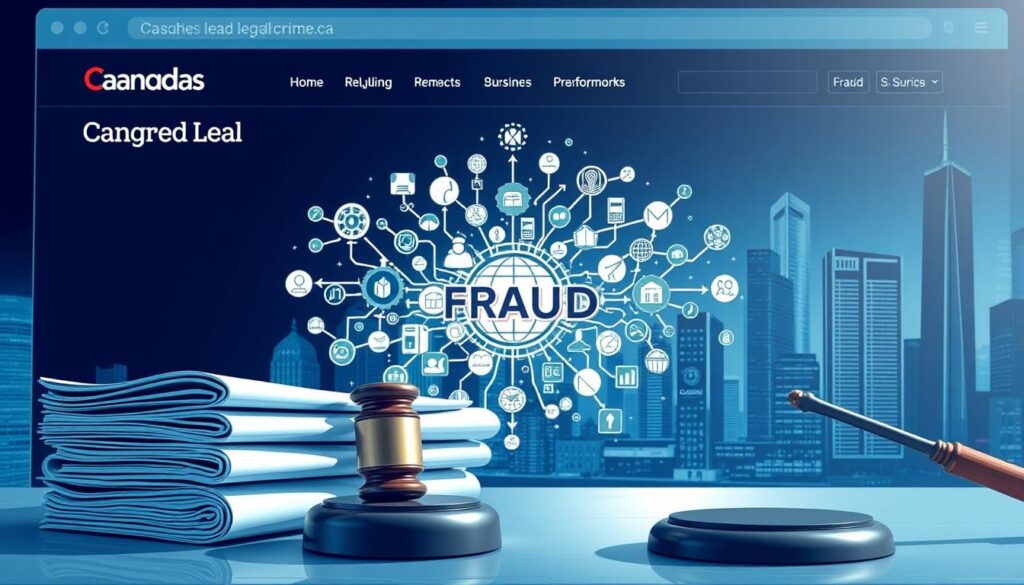Canadians lost over $530 million to scams in 2022. This figure represents thousands of victims who fell prey to sophisticated deception schemes. The digital age has created new opportunities for criminals to target unsuspecting individuals.
The Canadian Anti-Fraud Centre tracks these troubling trends. They provide vital information about current and emerging threats. Their data shows that anyone can become a victim, regardless of age, education, or technical knowledge.
Protecting yourself requires staying informed about common scammer tactics. These schemes are constantly evolving and growing more complex. From fake government calls to bogus investment opportunities, scammers use various methods.
This guide offers practical strategies to safeguard your personal and financial information. You’ll learn to spot warning signs and take preventive measures. We’ll also cover steps to follow if you suspect you’ve been targeted.
By using these protective measures, you can reduce your risk. Keep your assets secure by staying vigilant and informed.
The Growing Threat of Fraud in Canada
Fraud in Canada is rapidly evolving. Criminals are creating more complex schemes to target victims. As digital tech grows, so do opportunities for fraudulent activities.
The Canadian Anti-Fraud Centre (CAFC) reports fraud as a common criminal threat. It affects people of all ages and backgrounds in Canada.
Fraud schemes have become sophisticated operations. They can be hard to spot until it’s too late. These crimes cause financial hardship and erode trust in institutions.
Current Fraud Statistics in Canada
The CAFC reports Canadians lost over $379 million to fraud in 2021. This marks a big increase from previous years. Experts think only 5-10% of fraud victims actually report these crimes.
Identity theft reports have jumped 33% in two years. Investment fraud schemes have more than doubled since 2019. The COVID-19 pandemic sped up this trend.
| Fraud Type | Annual Losses (Millions) | Year-Over-Year Increase | Average Loss Per Victim |
|---|---|---|---|
| Identity Theft | $96.8 | 33% | $4,800 |
| Investment Fraud | $113.9 | 108% | $14,750 |
| Romance Scams | $64.6 | 18% | $21,900 |
| White-Collar Crime | $103.7 | 27% | $36,400 |
Most Vulnerable Demographics
Fraud can affect anyone, but some groups face higher risks. Seniors (65+) are very vulnerable, accounting for nearly 30% of reported losses.
Fraudsters often target older Canadians with big savings. They may be less familiar with new tech and sometimes face social isolation.
Newcomers to Canada are another high-risk group. They may fall for immigration scams, fake job offers, or housing fraud.
Young adults and students are often targeted on social media and online marketplaces. The CAFC says Canadians aged 18-30 are most at risk for identity theft.
Understanding these patterns is key to protecting all Canadians from fraud. We must develop effective strategies to combat these evolving threats.
Understanding Common Types of Fraud in Canadian Society
Recognizing fraud patterns is key to protecting yourself from scams. Fraudsters constantly adapt their methods to exploit new technologies. The Canadian Anti-Fraud Centre reports thousands of victims annually, with losses in the millions.
Identity Theft and Personal Data Breaches
Identity theft happens when criminals use your personal info for financial gain. Thieves gather data through mail theft, dumpster diving, and company database breaches.
Social engineering tricks people into revealing sensitive information through seemingly legitimate requests. Criminals can open credit accounts, apply for benefits, or commit crimes in your name.

Identity theft effects can be devastating and long-lasting. Victims often spend months repairing their credit history and financial reputation. Many experience emotional distress, feeling violated long after financial issues are resolved.
Financial Scams Targeting Canadians
Financial scams use emotional triggers and false urgency to bypass rational thinking. The Canada Revenue Agency (CRA) scam is common. Fraudsters pose as tax officials, claiming you owe money with immediate legal consequences.
Emergency scams target older Canadians by pretending to be relatives needing urgent financial help. Romance scams have increased with online dating. Fraudsters create fake profiles and establish emotional connections before inventing emergencies.
Phone and Email Scams
Phone and email remain the most common fraud delivery methods in Canada. Robocalls claim to be from agencies, banks, or tech companies seeking personal information.
Phishing emails mimic organizations with alarming messages about account security or deliveries. Watch for unsolicited communications, pressure tactics, and requests for unusual payment methods.
Investment Fraud
Investment fraud preys on the desire for financial growth. Pyramid schemes, Ponzi schemes, and fake cryptocurrencies promise unrealistic returns with minimal risk.
Be cautious of unregistered investments, guaranteed high returns, and recruitment pressure. Always verify opportunities through Canadian Securities Administrators before committing funds.
Emerging Cybercrime Trends
Cybercrime evolves with technology, creating new threats for Canadians. AI-powered phishing techniques now create convincing fake communications that fool even tech-savvy individuals.
Ransomware attacks have increased, targeting businesses and individuals. These attacks encrypt personal files and demand payment for release, often causing permanent data loss.
| Fraud Type | Common Methods | Warning Signs | Protection Strategies |
|---|---|---|---|
| Identity Theft | Mail theft, data breaches, social engineering | Unexpected bills, credit denials, unknown accounts | Credit monitoring, secure document handling, privacy settings |
| CRA Scams | Phone calls, emails demanding immediate payment | Threats of arrest, requests for gift cards/Bitcoin | Verify directly with CRA, never provide info to inbound calls |
| Romance Scams | Dating sites, social media, long-distance relationships | Never meeting in person, money requests, sob stories | Video chat verification, never send money to strangers |
| Cybercrime | Phishing, malware, ransomware, fake websites | Suspicious links, grammar errors, urgent requests | Two-factor authentication, updated software, backups |
SIM swapping is a new threat where criminals transfer your phone number to their device. This bypasses two-factor authentication and grants access to your accounts.
Staying informed about evolving threats is crucial for digital security. The Canadian Centre for Cyber Security regularly updates on new cybercrime trends and protection strategies.
How to Recognize Fraud: Warning Signs and Red Flags
Identifying fraud is crucial for Canadians in today’s scam-filled world. Thousands fall victim yearly, often not reporting due to shame or confusion. Knowing common warning signs helps develop a protective instinct against fraud.
Suspicious Communications and Offers
Fraudulent messages often have clear red flags. Look out for urgent deadlines or threats of negative consequences. Be cautious of demands for immediate action.
Poor grammar and spelling are common in phishing attempts. Be wary of generic greetings instead of your name. This is especially true for messages claiming to be from your bank.

The Canadian Anti-Fraud Centre warns against offers that seem too good to be true. Be suspicious of unexpected prizes or guaranteed high-return investments. Legitimate Canadian businesses don’t ask for gift cards or cryptocurrency as payment.
Unusual Financial Activities
Unexplained transactions, even small ones, can signal account security testing by fraudsters. Missing bank statements might indicate hidden fraudulent activity. Being denied credit despite good history could suggest identity theft.
Regular account and credit report monitoring is key for early fraud detection. Set up transaction alerts with your bank for unusual activity notifications.
“Most victims don’t realize they’ve been targeted until they notice unusual charges or receive collection calls for accounts they never opened.”
Social Engineering Tactics Used by Fraudsters
Social engineering uses psychological manipulation rather than technical hacking. Fraudsters often pose as authority figures to create a sense of legitimacy. Be wary of artificial time constraints pressuring you to make quick decisions.
Scammers exploit reciprocity by offering small favors to gain compliance later. For example, a “free security check” might be a ploy to access your system.
Recent Canadian fraud cases involved scammers using social media information. Limit personal details shared online to reduce vulnerability to targeted approaches. Stay vigilant and trust your instincts to protect yourself from fraud.
Protecting Your Personal Information from Identity Theft
Identity theft cases are rising in Canada. Protecting your info needs a strong defense plan. This covers both paper and digital risks. Luckily, you don’t need tech skills to stay safe.
Secure Management of Physical Documents
Thieves often target paper docs through “dumpster diving”. Get a good cross-cut shredder for sensitive papers. Store important docs in a fireproof safe or safety deposit box.
Go paperless when possible to reduce sensitive mail. Collect your mail promptly and put holds when away. Update your address quickly when moving to protect your info.
Digital Data Protection Strategies
The digital world has many cybercrime risks. Keep all devices and apps updated for security. Install good security software on all devices.

Secure your home Wi-Fi with a strong password. Use WPA2 or WPA3 encryption to prevent nearby hacking. This helps protect your personal information.
Secure Password Practices
Create unique, complex passwords for each account. Aim for 12+ characters with letters, numbers, and symbols. Use a password manager to generate and store them.
Never reuse passwords across accounts. Enable two-factor authentication when available for extra security. This adds another layer of protection.
Data Encryption Methods
Encryption turns data into unreadable code. Use built-in tools like BitLocker or FileVault for your hard drive. For sensitive files, try VeraCrypt or AxCrypt.
Use encrypted email or password-protected files when sending sensitive info. This helps keep your data safe during transmission.
Safe Cloud Storage
Choose cloud services with end-to-end encryption like Sync.ca or Tresorit. Read privacy policies before uploading sensitive info. Enable two-factor authentication for cloud accounts.
Avoid storing highly sensitive docs in the cloud unless necessary. This includes SIN numbers and banking information.
Social Media Privacy Settings and Practices
Social media can be risky for identity theft. Review privacy settings on all platforms. Be careful with Facebook, Instagram, and LinkedIn.
Don’t post info that answers security questions. Think twice before joining challenges that ask for personal details. These often collect info for theft.
Regularly check your friends list and remove strangers. Watch for fake account requests from contacts. Even innocent posts can give thieves valuable info.
Safeguarding Your Financial Accounts and Transactions
Protecting your financial transactions is crucial in Canada’s digital economy. Banks offer strong security measures, but your active role is vital. Knowing how to shield your accounts can prevent financial loss and fraud-related stress.
Banking Security Measures in Canada
Canadian banks use advanced systems to protect your assets. They offer real-time fraud monitoring that flags unusual transactions based on your spending habits. Transaction alerts via text or email notify you of suspicious activity immediately.
Two-factor authentication (2FA) adds a second layer of protection beyond your password. It requires a code sent to your mobile device to complete sensitive transactions.

- Set up account activity notifications for all transactions
- Establish transaction limits on your accounts
- Regularly update your online banking passwords
- Use the bank’s secure messaging system rather than email for sensitive communications
- Review your account statements weekly rather than monthly
Credit Card Protection Tips
Credit card fraud is common in Canada. Chip-and-PIN technology offers better protection than magnetic stripe systems. However, online transactions require extra caution.
Consider using virtual card numbers for online shopping. These temporary numbers link to your card but expire after one use. They protect your real card details from potential data breaches.
Canadian law limits your liability for fraudulent transactions to $50 if reported promptly. This protection doesn’t apply if you’ve shared your PIN. Never disclose your PIN to anyone—not even bank employees.
| Security Measure | Credit Cards | Debit Cards | Effectiveness |
|---|---|---|---|
| Chip-and-PIN | Standard in Canada | Standard in Canada | High |
| Transaction Alerts | Available with most issuers | Available with most banks | Medium-High |
| Liability Protection | Limited to $50 if reported | Varies by bank | Medium |
| Virtual Card Numbers | Available with select issuers | Not typically available | Very High |
Preventing Money Laundering and Financial Crimes
Your accounts can become targets for money laundering schemes without your knowledge. Fraudsters may try to use your identity to open accounts or move illegal funds.
Watch for unexpected deposits followed by transfer requests. Be wary of job offers involving receiving and transferring funds. Don’t share your banking information unexpectedly.
Protecting yourself from money laundering preserves your financial reputation and credit history. Never allow others to use your accounts, even if they offer payment. Such deals are often money laundering attempts.
Report unusual account activity to your bank immediately. Canadian banks must report suspicious transactions to FINTRAC. Your vigilance is the first defense against financial crimes.
Online Security: Defending Against Phishing and Cyber Fraud
Canadians need strong cybersecurity habits to protect against online fraud. Cybercriminals use phishing, malware, and hacking to exploit weaknesses. Luckily, basic security practices can keep you safe online.
Secure Browsing and Shopping Practices
Always check for a padlock icon and “https://” in your browser’s address bar. This shows a secure connection. Good websites have clean designs, working links, and few spelling mistakes.
Use these essential security measures when shopping online:
- Use credit cards rather than debit cards for better fraud protection
- Create unique passwords for each shopping account
- Verify merchant reputation through reviews and the Better Business Bureau
- Avoid making transactions over public Wi-Fi networks
- Check for secure payment processing symbols like Verified by Visa or MasterCard SecureCode
Shopify and Amazon.ca offer built-in security, but stay alert everywhere you shop. Real businesses won’t rush you to buy or use odd payment methods.
Two-Factor Authentication Implementation
Two-factor authentication (2FA) adds a second layer of security beyond your password. It requires your password and something you have, like your phone.

- Access your account security settings
- Look for “two-factor authentication” or “2FA” options
- Choose your preferred verification method (SMS codes, authenticator apps, or hardware keys)
- Follow the setup instructions to link your verification device
Enable 2FA for your financial accounts, email, CRA MyAccount, and social media profiles. Authenticator apps offer stronger protection than SMS codes.
Protecting Your Devices from Malware and Hacking
Your devices are gateways to your digital life. Keep all systems and apps updated to patch known security flaws.
Install trusted security software from Norton, McAfee, or Bitdefender. Set it to update automatically. Watch out for these threats:
- Ransomware that encrypts your files and demands payment
- Banking trojans designed to steal financial credentials
- Keyloggers that record everything you type
- Fake COVID-19 information apps containing spyware
Scan your devices often for malware. Look for signs like slowdowns, strange pop-ups, or odd account activity. Back up your data regularly to protect against ransomware.
The Canadian Centre for Cyber Security offers free advice for Canadians facing digital threats. Use their resources to stay safe online.
Canadian Legal Framework: Laws and Regulations on Fraud
Canada has robust laws to fight fraud at federal and provincial levels. These laws define fraudulent activities and set penalties. Knowing these laws helps you recognize fraud and understand your rights.
The legal system tackles fraud through criminal prosecution and consumer protection. This creates multiple layers of defense against fraudulent acts.

The Criminal Code of Canada on Fraud Offenses
The Criminal Code is Canada’s main federal law addressing financial crimes. It defines fraud as depriving someone of property or money through deceit.
The Code also covers identity fraud and credit card fraud. It recognizes the changing nature of white-collar crime in our digital world.
Canadian courts interpret these laws to ensure complex fraud schemes don’t escape punishment. The Code provides a unified approach to fraud prosecution across Canada.
Penalties for Fraud Over $5,000
Fraud over $5,000 is a serious offense with harsh consequences. Offenders can face up to 14 years in prison. Courts may also impose large fines and order fraudsters to repay victims.
Penalties for Fraud Under $5,000
For fraud under $5,000, prosecutors can choose between indictment or summary conviction. Summary conviction can result in up to two years less a day in jail.
Even minor fraud cases can lead to criminal records. This can impact future employment and travel opportunities.
Identity Theft Legislation
Recent changes to the Criminal Code have improved protections against identity theft. Possessing identity information for fraud is now a crime. So is fraudulently impersonating others.
These offenses can lead to up to five years in prison. This reflects the serious nature of identity crimes today.
Provincial Consumer Protection Laws
Each province has consumer protection laws that address fraudulent business practices. These laws offer more help for victims of marketplace fraud.
Ontario’s Consumer Protection Act bans unfair practices like false or misleading representations. British Columbia and Quebec have similar laws protecting consumers from deceptive practices.
These provincial laws often allow for civil remedies beyond criminal charges. These can include contract cancellation, refunds, and damages.
Many provinces have consumer protection offices. These can investigate complaints, mediate disputes, and sometimes take action against fraudulent businesses.
Knowing both federal and provincial laws gives you a full picture of your rights. These laws work together to punish fraudsters and help victims.
Steps to Take If You’ve Become a Victim of Fraud
Falling victim to fraud in Canada can be overwhelming. Quick action in the first 24-48 hours is crucial. A systematic approach can help you regain control and minimize losses.
Immediate Actions to Protect Yourself
Take these urgent steps to prevent further damage:
- Contact your financial institutions immediately to freeze compromised accounts and cards
- Change passwords and PINs for all affected accounts, using strong, unique combinations
- Document everything related to the fraud incident, including suspicious emails, text messages, and phone calls
- Keep detailed notes of all conversations with authorities and financial institutions, including names, dates, and reference numbers
- Place fraud alerts on your credit reports through Equifax and TransUnion
Act quickly, even if the fraud seems minor. Scammers often test small transactions before attempting larger schemes. Keep all evidence for filing reports with authorities.

Reporting Fraud to Canadian Authorities
Proper reporting helps track fraud patterns and may aid in recovery. Different types of fraud require reporting to specific agencies in Canada.
Police Reports
File a report with local police for significant financial losses or identity theft. Bring all documentation and request a copy for insurance claims. Some institutions require police report numbers for fraud claims.
Canadian Anti-Fraud Centre
Report all fraud incidents to the Canadian Anti-Fraud Centre (CAFC). Contact them online or by phone at 1-888-495-8501. The CAFC collects data on scams affecting Canadians.
This helps authorities identify trends and warn the public about emerging schemes. Your report can protect others from falling victim.
Financial Institutions
Contact the fraud departments of your bank, credit union, or credit card companies. Most have specialized fraud teams with specific protocols. They can guide you through investigations and explain liability protection.
Recovery and Remediation Strategies
After immediate action and reporting, focus on long-term recovery:
- Monitor your credit reports regularly for at least a year following the incident
- Consider a credit monitoring service or identity theft protection plan
- Dispute fraudulent charges or accounts with creditors and collection agencies
- Rebuild your credit score by maintaining on-time payments and keeping credit utilization low
Recovery from fraud takes time and can have emotional impacts. Consider joining support groups for fraud victims. Sharing experiences can provide valuable insights and emotional support during recovery.
| Fraud Type | Primary Reporting Agency | Secondary Reporting | Recovery Timeline |
|---|---|---|---|
| Credit Card Fraud | Card Issuer | CAFC, Police (if large amount) | 1-3 months |
| Identity Theft | Police | CAFC, Credit Bureaus | 6-12 months |
| Investment Scams | Provincial Securities Commission | CAFC, Police | 3-24 months |
| Tax Fraud/Embezzlement | Canada Revenue Agency | Police, CAFC | 12-36 months |
Canadian Resources and Support for Fraud Victims
Canadians affected by fraud have access to many support services. These resources can help you recover and prevent future incidents. You’re not alone in this difficult situation.

Government and Law Enforcement Resources
The Canadian Anti-Fraud Centre (CAFC) collects information on fraud and identity theft. They offer guidance and maintain databases of current scams. You can report incidents online or call 1-888-495-8501.
The Competition Bureau looks into deceptive marketing and business-related financial crimes. Their website provides resources for consumers affected by marketplace fraud.
Local police and the RCMP investigate fraud cases. Reporting creates a record that may help identify larger fraud patterns. The Office of the Privacy Commissioner assists with data breaches.
Provincial consumer protection offices offer region-specific support. Their services are tailored to local laws and common fraud schemes.
Non-Profit and Consumer Advocacy Organizations
The Canadian Identity Theft Support Centre helps victims of identity theft. Their counselors guide you through reclaiming your identity and securing personal information.
Organizations like Credit Canada offer free counseling to rebuild your finances after embezzlement or fraud. They help with credit report corrections and recovery plans.
Provincial consumer groups provide educational resources and direct support for fraud victims. They often offer mediation services when dealing with fraudulent businesses.
The Better Business Bureau has a scam tracker database. You can report incidents and research common fraud schemes in your area.
These Canadian resources form a network to help you recover. They can guide you in rebuilding your financial security with confidence.
Conclusion: Staying Vigilant in the Fight Against Fraud
Protecting yourself from fraud requires ongoing commitment. Cybercrime tactics evolve, so your defense strategies must adapt too. Stay informed about new scams through the Canadian Anti-Fraud Centre.
Your awareness helps in the broader fight against fraud. By recognizing and reporting scams, you assist authorities in tracking patterns. This collective vigilance reduces fraud’s impact across Canadian communities.
Set reminders to review your security practices regularly. Update passwords, check account statements, and verify unusual requests. These simple steps can prevent you from becoming a victim.
Studies on fraud prevention show organizations typically lose 1-5% of revenue to fraud. However, those with strong prevention systems experience lower rates.
Mark your calendar for Fraud Prevention Month 2025. Use this time to refresh your knowledge on recognizing and reporting fraud. With the right tools, you can reduce your risk significantly.
By staying informed, you contribute to a safer digital environment for all Canadians. Your vigilance makes a difference in the fight against fraud.

